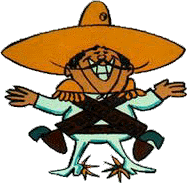 Another Stereotype of the Month entry:
Another Stereotype of the Month entry:
 Another Stereotype of the Month entry:
Another Stereotype of the Month entry:
Roadside Distraction
David McGrath, PopPolitics.com
July 19, 2002
His nose must be over a foot wide at its base. True, I did not climb the billboard and measure with a ruler, but I can vouch that the Indian's nose is broader than each of his arms and legs. This is no 1950s relic staring down at me. The modern billboard towers each day over drivers on Interstate 294 in Alsip, 20 miles outside Chicago: a tri-color image of an Indian aligned to the left of a banner for Arrow Chevrolet.
Get it? Arrow...Indian?
Here's what drivers see: big nose, little legs, dark skin, headband and single feather. He wears a necklace strung from animal teeth and a loincloth. He displays the same bow-and-arrow combative behavior that Hollywood used to feature.
The same buffoonish character is stenciled on Arrow's showroom windows in Midlothian, another Chicago suburb, and on Arrow's Web site, ostensibly to boost recognition of its company name.
What Arrow has done is essentially resurrect the cigar store Indian to shill for Chevrolets. Some Americans may remember the wooden statues of Indians placed in front of drug stores and tobacco emporiums. They were used to advertise cigarettes and cigars, a practice vaguely related to some Indian tribes' use of pipes and tobacco in sacred ceremonies.
Would objecting to Arrow's ad campaign be just another hysterical charge of political incorrectness? After all, what's the harm?
"It's hurtful, dehumanizing," says Arieahn Matamonasa, a psychologist and professor of contemporary Native American issues at DePaul University.
Matamonasa made the dealership aware of its display ad's offensive nature as early as four years ago, when she commissioned her students to write research papers on the dangers of stereotyping. Each year since then, several of her students have tackled the subject of the Chevy Indian and have written to the dealership's management.
"They've ignored all of our letters," says Matamonasa, who has crow-black hair that hangs well below her shoulders, and the straight-on, relentless gaze that reminds one of Natalie Wood's character in The Searchers, except that Matamonasa is, indeed, of Lakota and Menominee descent.
She is concerned particularly about the social and potentially violent consequences of stereotyping, recalling the cartoons Julius Streicher published prior to and during WWII that gave public "permission" for dehumanizing and exterminating Jews.


Matamonasa compares the Chevy Indian caricature to Chief Wahoo, the mascot of the Cleveland Indians baseball team, and to the "Frito Bandito," the cartoon character eventually retired, under pressure, by Frito Lay (click here for a Fritos commercial clip).
"He has a feather tucked in a headband, and he has no shirt. He looks ridiculous," she told me. "And we are such a small group that people don't have real life experiences with Indian people. So for them, he represents the whole culture.
"When people see, on the other hand, something like the leprechaun of the Fighting Irish of Notre Dame, they know enough of the Irish culture that this mythic figure is not representative."
As a cartoon image, this is not the characteristically touted noble, sacred or serious Indian stereotype, ala University of Illinois's Chief Illiniwek, the school's mascot. Neither is it a frolicsome or supposedly innocent depiction, like Disney's Pocahontas. The Arrow Chevy Indian is, in fact, more akin to the TV series Pow Wow the Indian Boy meets F-Troop — which may speak to the age as well as to the cynicism of the dealership's management.
Perhaps because the company would be hard-pressed to claim, as does the U. of I. or the Atlanta Braves, that they are "honoring" Indians with their billboard and Web site art, they have decided not to talk at all: The general manager of Arrow would not return my calls.
Rob's comment
See the mascot in question at Arrow Chevy. Note the repeated arrow-into-target motif, which reinforces the notion of Indians as violent, primitive, and living in the past.
I'd say don't bother writing Arrow Chevrolet unless you send a copy to General Motors' headquarters. If GM's executives receive enough complaints, they'll force the local dealer to change no matter what his rationalizations are.
Related links
Team names and mascots
Chief Wahoo
Uncivilized Indians
|
. . . |

|
All material © copyright its original owners, except where noted.
Original text and pictures © copyright 2007 by Robert Schmidt.
Copyrighted material is posted under the Fair Use provision of the Copyright Act,
which allows copying for nonprofit educational uses including criticism and commentary.
Comments sent to the publisher become the property of Blue Corn Comics
and may be used in other postings without permission.